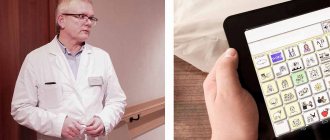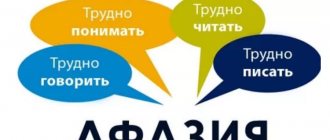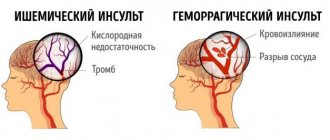Acoustic-mnestic aphasia
The term “acoustic-mnestic aphasia” was introduced and widely used by the founder of Russian neuropsychology, Professor A.R. Luria. Some authors use the name “sensory-mnestic aphasia.” The pathology refers to the posterior forms of aphasic speech disorders. According to experts in the field of neurology and speech therapy, an isolated form of aphasia practically does not occur; usually speech disorders are mixed in nature with simultaneous dysfunction of 2-3 mechanisms. Most often, acoustic-mnestic aphasia is observed in the acute period of stroke. The speech defect is mildly expressed, sometimes goes unnoticed against the background of other neurological symptoms, and in some cases is mistaken for cognitive decline or a neurodynamic disorder.
Symptoms and manifestations
Amnestic aphasia is characterized by a mild course of the disease and a blurred manifestation of the clinical manifestations of the disease. Among the most common manifestations are the following symptoms:
- Slow speech of the victim, with pronounced intervals between sentences, or vice versa, the victim’s speech becomes fluent, illogical, turning into “porridge”;
- Repeated repetition of the same words or phrases;
- The presence of paraphrases is a descriptive characteristic of the semantic load of a word. Speech becomes descriptive;
- The patient misses words, most often nouns;
- Also, the patient cannot remember the name of the item or object in question, but knows its function and appearance.
Despite this, the patient's reading and writing skills do not suffer. His speech is constructed correctly, both grammatically and logically. The patient does not have difficulties with the acoustic pronunciation of words, as well as articulation. The patient's speech becomes expressive and replete with a large number of verbs.
It is important to note that the patient easily remembers the name of an object when prompted or in context, for example, if you name the first syllable of the desired word, the patient will easily remember its ending.
Causes of acoustic-mnestic aphasia
The pathology develops as a result of damage to the cortex of the mid-posterior parts of the middle temporal gyrus of the dominant hemisphere - Brodmann's cytoarchitectonic areas 21 and 37. Changes in cerebral tissues can be ischemic, inflammatory, destructive, or compressive in nature. Possible causes of damage are:
- Strokes.
The most common cause of speech disorders. According to various data, aphasia is observed in 30-60% of patients with stroke. In ischemic stroke, the mnestic form of aphasia occurs due to lack of blood supply and hypoxia of the corresponding area of the cerebral cortex; in hemorrhagic stroke, it occurs as a result of compression of tissues by gushing blood. - Traumatic brain injuries.
Contusion, crushing of cerebral tissue, and the formation of intracerebral hematoma lead to damage and death of neurons responsible for auditory-verbal memory. The damaged area expands due to post-traumatic edema and inflammation. - Intracerebral tumors.
Primary and metastatic tumors in the temporal regions of the brain cause speech disorders in two ways. Invasively growing neoplasias cause destruction of surrounding tissues. As they grow, isolated tumors begin to compress the cerebral structures and the vessels that feed them. - Infectious and inflammatory diseases.
Encephalitis, meningoencephalitis, cerebral abscesses with foci of inflammation located in the 21st, 37th fields lead to dysfunction of the neurons responsible for speech. Inflammatory edema, compression, dysmetabolism in the affected area cause apoptosis of nerve cells and disruption of interneuronal connections. - Progressive degenerative processes.
The initial stages of Alzheimer's disease, Pick's disease, and Schilder's leukoencephalitis can occur with focal degeneration and demyelination of the middle temporal gyrus region. Progressive acoustic-mnestic dysfunction occurs, eventually turning into mixed sensorimotor aphasia.
Thus, when briefly summing up the methodology for restoring speech understanding in sensory aphasia, when constructing it, attention is drawn to the following:
1) significant place is given to the semantics of speech and reliance on it;
2) a significant role is given to methods that create the interaction of various analyzing systems (for example, the method of oral and optical control of sound recognition) and various levels of organization of speech understanding (for example, the method of audible reading);
3) work begins with texts, and not with individual sounds;
4) a significant place in the teaching methodology is occupied by non-verbal methods - intonation, game method (subject lotto, digital lotto, etc.), classification, etc.;
5) the work is carried out with the widespread use of the method of introducing into context;
6) all work is based on the patient’s personality and emotional state;
7) considerable attention is paid to the selection of material.
7.2. Methods for speech restoration in acoustic-mnestic aphasia
Acoustic-mnestic aphasia syndrome occurs when the middle temporal gyrus of the left hemisphere cortex is damaged (Brodmann fields 21 and 37). This area of the cortex has a complex structure and connections not only with the auditory analyzer, but also with the visual, as well as with the mediobasal areas related to affective processes, and the limbic areas of the brain associated with mnestic processes. This feature of morphological formations was reflected in the mechanisms and syndrome of acoustic-mnestic aphasia. The basis of the originality of speech in this case is a violation of the interaction of two analytical systems - acoustic and visual. Therefore, the control mechanism underlying the syndrome of acoustic-mnestic aphasia is a violation of not one, but several factors: a narrowing of the scope of perception, a violation of operational auditory-verbal memory, a violation of the gnostic basis of speech (defects in visual object images).
Based on these mechanisms, central defects arise: violation of repeated speech, as well as naming objects and understanding speech. It is important to note that with this form of aphasia, written speech (writing and reading) remains intact. This most complex and more abstract form of speech arises later than oral speech and in other ways; it also has a different structure.
Unlike sensory aphasia, in this form of aphasia, phonemic hearing remains intact and, therefore, the process of sound discrimination is not primarily impaired. Therefore, in the oral expressive speech of these patients there are not literal, but verbal paraphasias, and in the oral expressive speech (In the process of understanding speech) - not literal, but verbal: paragnosia. In the clinical picture of this form of aphasia there is no logorrhea (or unproductive verbosity), speech understanding is impaired, but not grossly. The phenomenon of alienation of the meaning of words occurs against the background of possible correct repetition of the word, i.e. misunderstanding of the word in this case is not associated with defects in sound discrimination, but is related to defects in the visual-objective basis of the word, to a violation of working memory and to a narrowing of the scope of perception.
Restorative education of patients with this form of aphasia puts forward the restoration of the gnostic sphere of speech, that is, the restoration of visual object images and their connection with the word, as the first and central task. The second task of training is to work on increasing the volume of perception. Restoring these skills will lead to the restoration of the actualization of words-names of objects, repeated speech, and understanding.
The task of the first stage of training is the restoration of visual-object images and the subject-relatedness of the word. Patients have grossly impaired understanding of the simplest everyday objects, there are difficulties in correlating a word with an object (object, phenomenon), in spontaneous speech there is a search for words-names, their absence, verbal paraphasias. Drawing an object by word is difficult, and in many cases inaccessible. All this is accompanied by a clear impairment in understanding speech, even when spoken. Therefore, in these cases, training begins with a “system of techniques,” including methods of subject classification, introducing objects into various categories, working with the subject in all its connections with other objects, drawing techniques, etc.
The work begins with a group of pictures (no more than 15-20), in which the same object must be repeated, but from a different angle or made with different colors, etc. These object pictures (and real objects, dummies) are “played out” with different aspects: objects are sorted into groups according to various given characteristics, independently identified by patients, work is done to highlight common and distinct characteristics of objects, pictures are introduced into generalized groups by category or according to situational characteristics; in this case, the method of memorizing given pictures and finding them among them is effective others, similar in external configuration, etc. These and other techniques create in the patient a readiness to perceive object images, memorize them, and generalize perception; they also revive the sphere of visual images. After such preparatory work, targeted classifications are made according to given characteristics, qualities, and general external data, etc. (classification according to general characteristics: “furniture”, “transport”; according to external characteristics: everything is round, everything has a handle; according to functions: what rides, what grows, etc.). Classification is done first by visual patterns and later by words.
Chapter 7. Restoration of oral impressive speech (continued) – previous | the next one is 7.2. Methods of speech restoration for acoustic-mnestic aphasia (continued)
Content. Neuropsychological rehabilitation of patients. Speech and intellectual activity.
Pathogenesis
Speech articulation and phonemic hearing are normal. The pathogenetic basis of this speech disorder is a violation of auditory-verbal memory. According to assumptions, patients have increased inhibition of auditory-verbal traces. Clinically, this is expressed by forgetting previously heard words when perceiving new ones. Another pathogenetic aspect of this pathology is the limited volume of auditory-verbal memory. The defect negatively affects the ability to write, count, and read.
In most cases, damage to the posterior temporal areas (field 37) is accompanied by a disruption of their connection with nearby optical-gnostic structures of the occipital lobe. As a result, difficulties arise in the relationship between the verbal designation of an object and its visual image, and the semantic side of speech suffers. The consequence is clinically observed difficulties in perceiving what is said and difficulties in selecting the necessary words in expressive speech.
general information
Aphasia is the most common complication of strokes and other brain lesions. According to statistics from the World Health Organization, 30% of people with speech disorders are of working age. Moreover, 80% of them are disabled due to speech impairments.
The acoustic-mnestic type of pathology was identified by A. Luria. He noted that patients retain the ability to repeat individual words and understand them, however, when writing from dictation or when communicating with long sentences, patients begin to make mistakes.
The disease is accompanied by impaired auditory-verbal memory and a decrease in the volume of acoustic perception. Patients with such disorders remain critical of their condition and complain that during a conversation they do not understand well what they hear, and they themselves have difficulty finding words.
Symptoms of acoustic-mnestic aphasia
A typical dissociation is between the impaired ability to repeat several words addressed to the patient and the normal reproduction of a single word spoken. Due to the limitation of auditory-verbal memory, the patient is able to repeat the first and last or only one word from a verbal chain. The patient explains this as a problem with remembering. The situation repeats itself when listening again. Difficulty understanding long statements and simultaneous communication with several interlocutors. After listening to an instruction of 5-7 words, the patient grasps its essence, but may perform it with errors (for example, perform the specified action with another object).
Expressive speech is accompanied by difficulties in selecting the right word, which is associated with dysfunction of the optical-gnostic component. The resulting “blurring” of the meaning of words causes a large number of verbal paraphasias - verbal substitutions that are not always suitable in meaning. Agrammatisms are represented mainly by inconsistencies between verbs, nouns, and pronouns in number and gender. The patient experiences difficulty expressing his own thoughts, describing pictures, and composing a story in separate parts.
Dysgraphia is more pronounced when writing from dictation and is characterized by a greater number of agrammatisms than in oral speech. Patients do not remember dictated phrases well, often ask to repeat fragments of them, and are able to retain no more than three words in memory at a time. Dyslexia is observed when reading texts with sentences of significant length. A disorder of auditory-verbal memory causes the inability to retain the text being read in the head, which leads to a lack of understanding of what is read. Acalculia is expressed in difficulty in arithmetic operations with multi-digit numbers, since the patient cannot remember numbers transferred from one digit to another.
Clinical manifestations
A distinctive feature of acoustic-mnestic aphasia is the inability of a person to repeat a series of words heard, while maintaining the ability to pronounce them separately. Limitation in auditory-verbal memory leads to the fact that, having heard a chain of words, the patient is able to pronounce only individual words, most often the last ones. Repeated listening to a verbal chain does not lead to improved memorization. This makes it impossible to communicate with several people at the same time, and also impairs the perception of complex sentences consisting of a large number of words. If an instruction is read to a patient with aphasia, he will be able to follow the sequence, but will not be able to repeat what he heard.
During his own speech, the patient cannot quickly select words. Paraphasia occurs - the use of verbal substitutions that are not equivalent in meaning. During a speech therapy examination, agrammatisms associated with the inconsistency of individual words with each other are determined. If you ask the patient to describe thoughts or images, the story will be abrupt and difficult for him.
Dysgraphia has a number of features and manifests itself when writing from dictation. The number of agrammatisms is increasing. While writing, the patient constantly tries to repeat heard fragments in order to facilitate their writing. However, memory is limited to 2-3 words. Dyslexia is less common. It can only be identified when reading long sentences with a complex syntactic structure. Impaired fixation of read information causes a lack of understanding of its meaning and the inability to retell the text. Counting violations are detected in a small percentage of cases.
Emotional and volitional disorders also occur: mood lability, constant anxiety and “fussiness” are noted. With an extensive lesion, clinical manifestations may affect other areas of the patient’s personality.
Complications
Aphasia interferes with the patient’s normal communication with others, depriving him of the ability to fully read, write, and perform arithmetic operations. These changes adversely affect the quality of life and the level of social adaptation. Patients are frustrated by their inability to accurately convey their thoughts to others. There are also concerns about concomitant neurological disorders in the motor sphere and disability. On this basis, the development of neurotic disorders (hypochondria, depression) and the accentuation of negative character traits are possible. The situation is aggravated if acoustic-mnestic aphasia is mistaken by doctors and loved ones for a cognitive disorder. The lack of specialized treatment leads to persistent speech dysfunction.
Diagnostics
The acoustic-mnestic form is not obvious; to identify it during the initial consultation of the patient, a comprehensive study of speech function is necessary. Diagnosis is carried out through the joint efforts of a number of specialists: neurologist, aphasiologist, neuropsychologist, psychiatrist, speech therapist. Since the diagnosis of “aphasia” is syndromological, clarification of the etiology of the process is required. A comprehensive examination of the patient includes:
- Neurological Research
. The neurological status reveals concomitant focal neurological deficits: spastic hemiparesis, pathology of the cranial nerves. Assessment of cognitive abilities is of great importance. In case of deviations in mental status, consultation with a psychiatrist is required. - Diagnostic speech examination.
It is carried out by a speech therapist and aphasiologist in a comprehensive manner. Verbal paraphasia, agrammatisms, decreased auditory-verbal memory, dyslexia, and dysgraphia are detected. Optical-gnostic dysfunction is diagnosed by the absence of distinctive details of the object in the patient’s drawings: a handle on a cup, a spout on a teapot. - MRI of the brain.
Allows you to determine the morphological substrate of the disease. Visualizes tumor processes, inflammatory foci, degenerative changes, ischemic areas, intracranial hematomas, traumatic injuries. - Vascular Research
. Doppler ultrasound, duplex scanning, and MR angiography are prescribed if cerebrovascular pathology is suspected. They help confirm changes in cerebral blood flow, vessel occlusion, and assess the state of collateral circulation. - Lumbar puncture.
It is performed if there is clinical evidence of a neuroinfection in order to obtain and study cerebrospinal fluid. When carrying out laboratory tests, inflammatory changes, a specific pathogen, tumor cells, and signs of hemorrhage are determined.
Acoustic-mnestic aphasia is differentiated from other speech disorders. Active expressive speech eliminates motor aphasia, in which speech production is severely limited. In contrast to acoustic-gnostic aphasia, the mnestic form is characterized by more complete utterances, the absence of literal paraphasia, and “speech salad.” Careful examination of speech makes it possible to distinguish aphasia from cognitive impairment.
Treatment of acoustic-mnestic aphasia
Correction of a speech defect is carried out against the background of mandatory therapy for the underlying pathology. Depending on the type of stroke, thrombolytic or hemostatic therapy is carried out. In case of a tumor or hematoma, together with neurosurgeons, the possibility of radical removal and radiotherapy is considered. Patients with neuroinfection are prescribed etiotropic antibacterial or antiviral treatment. Therapy for speech disorders itself includes two components:
- Speech therapy classes.
The goal of speech therapy correction is to expand the volume of operational auditory-verbal memory. If possible, classes begin from the first days of the disease and are carried out in stages with a gradual increase and complication. Initially, tasks are performed based on visual perception, then short auditory dictations are carried out. It is recommended to memorize and recall speech sequences, poems, and songs. Difficulties in selecting words in speech are overcome by clarifying their meaning, systematization, and comparing synonyms and antonyms. - Pharmacotherapy.
Necessary for stimulating metabolic processes in the brain, restoring lost neural connections and functions. Produced by vascular (vinpocetine), nootropic (piracetam), neurometabolic (gamma-aminobutyric acid) drugs. The drug memantine has proven itself well in the treatment of aphasia.
During the rehabilitation period, the patient needs the help of loved ones. Productive communication is possible by reducing the rate of speech and eliminating long, complex statements. Maintaining verbal contact from relatives and assistance in performing speech therapy exercises at home contribute to the speedy restoration of speech function. It is effective to carry out speech therapy rehabilitation against the background of general restorative rehabilitation exercises, exercise therapy, massage, and psychotherapy.
Prognosis and prevention
The outcome of acoustic-mnestic aphasia largely depends on the etiology of the causative disease and the timeliness of speech therapy treatment. Persistent step-by-step therapy often allows you to restore speech function after a stroke, head injury, or encephalitis. Unrecognized aphasia that remains uncorrected may undergo a slight regression, but speech impairments turn into a persistent residual defect. Aphasia of tumor and degenerative origin has the most unfavorable prognosis. Preventive measures include timely treatment of cerebrovascular diseases, exclusion of oncogenic effects, prevention of injuries, strengthening the immune system
LiveJournal
Prevention of violations
Preventive measures are aimed at the primary prevention of diseases that can lead to speech disorders. Neurologists make a number of general recommendations:
- use protective helmets during professional activities and some sports;
- if you have diseases of the internal organs, for example, diabetes mellitus or atherosclerosis, promptly seek medical help and follow the instructions of your doctor;
- follow the principles of a healthy diet: give up fast food, fried or smoked foods, add fruits, vegetables, lean meat and other healthy foods to your diet;
- regularly engage in sports - cardio training and exercises in the gym;
- Avoid drinking alcohol and smoking.
If you experience difficulty finding words or other symptoms, you should immediately seek medical help.







